Species Distribution
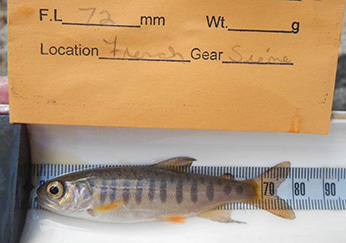
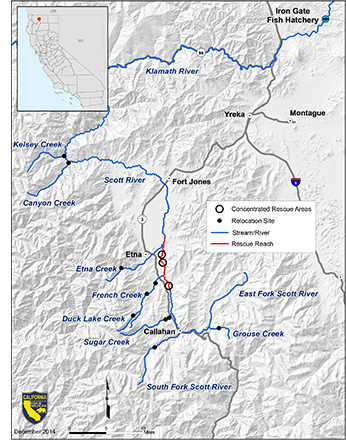 (click/tap to enlarge)
(click/tap to enlarge)
The Scott River, located in Siskiyou County, is a tributary to the Klamath River, and a major stream for coho salmon (see map). In California, spawning populations of coho salmon (Oncorhynchus kisutch) occur from the Smith River in Del Norte County, near the Oregon border to Aptos Creek to the south in Santa Cruz county. Historical records show that coho salmon occurred in 582 California streams, but by 1991 had been lost from about half these streams (Moyle 2002). Coho salmon in the Southern Oregon Northern California Coast Evolutionarily Significant Unit (SONCC ESU) were listed as threatened under the Federal Endangered Species Act in 1997, and formally listed as threatened under the California Endangered Species Act in 2005. Some major human stresses contributing to recent and historic population declines include loss or degradation of habitat caused by dams, water diversions, marijuana cultivation, poor logging practices, agricultural land development and overfishing. Natural stress factors may include floods and droughts, poor ocean conditions, disease, predation, wildfires and poor water quality.
Necessity of Rescue
Minimal rainfall precipitation and lack of snowfall during the fall and winter of 2013-2014 resulted in low stream flows throughout the Scott River watershed. Many tributary streams in the watershed where coho salmon typically spawn were experiencing very low flows and, with the exception of French Creek, were not connected to the mainstem Scott River until mid-February. Approximately 2,700 adult coho salmon ascended the Scott River from the Klamath River to spawn during the 2013-2014 spawning season, and being unable to reach their tributary spawning grounds, many spawned within a 10 mile reach of the Scott River mainstem (see map).
With the drought expected to continue well into the summer, potentially causing stream flow to diminish severely in critical sections of the river, a number of agencies and community groups recognized the potential need for emergency fish rescues. CDFW staff and partners; Scott River Water Trust (SRWT), Siskiyou Resource Conservation District (SisqRCD), Klamath National Forest (USFS), NOAA Fisheries, Karuk Tribe and Quartz Valley Indian Reservation (QVIR) began planning for a potential fish rescue effort and initiated flow and temperature monitoring at possible release sites. Throughout the spring and summer of 2014, the SRWT worked to obtain water leases from willing ranchers to enhance flows, and CDFW and the SisqRCD conducted snorkel surveys of juvenile coho salmon throughout the Scott River at known adult spawning grounds and nearby juvenile rearing sites.
Rescue Methods
During May through August 2014, CDFW and partner groups captured juvenile salmonids (coho salmon along with steelhead trout and Chinook salmon) from the mainstem Scott River, and some tributary reaches where flows were diminishing, using incline traps (Figure 1), seine-nets (Figure 2) and dip-nets. Rescue activities included relocating fish from areas where stream flows were diminishing, as well as relocating fish from some areas of the mainstem where the amount of habitat available was likely to decline over time as stream flows declined. Captured fish were transported in aerated transport tanks filled with stream water. Water temperature in the tank was monitored and de-chlorinated ice added as necessary to cool tank water during capture activities. Fish numbers were determined by measuring and calculating the number of fish by total weight and applying the ratio to the total weight during each rescue.
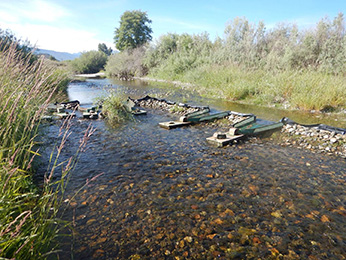 Figure 1.
Figure 1.
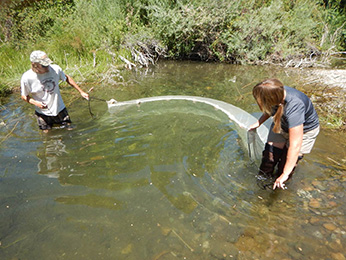 Figure 2.
Figure 2.
Relocation Site
An estimated 110,619 juvenile salmonids (88% coho, 12% steelhead and 0.1% Chinook) were relocated to upper Scott River tributaries at 10 different pre-determined (Figure 3) sites and an estimated 4,447 coho salmon were transported to holding tanks in the Iron Gate Hatchery on the Klamath River. Before any wild coho salmon were relocated to Iron Gate Hatchery, live chill boxes, bio-filtration and isolated UV-treated circulation tanks were purchased and installed at the hatchery. Three tanks were available, but only two were utilized. Fish were chemically treated for potential parasitic and bacterial diseases and carefully monitored.
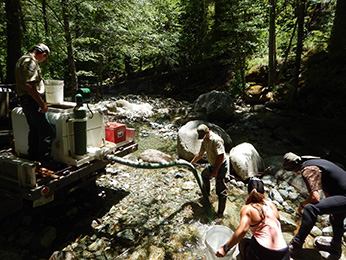 Figure 3.
Figure 3.
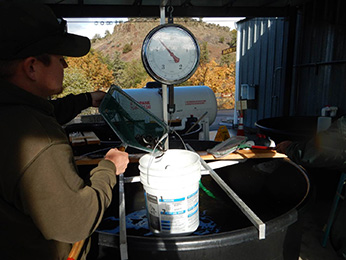 Figure 4.
Figure 4.
Release of Rescued Hatchery Reared Fish
When stream conditions improved, captured coho rearing in the isolated tanks at Iron Gate Hatchery were released back into the wild. There was some mortality while the wild fish were in captivity. Estimated numbers of coho rescued and released are based on weight counts (Figure 4). The number of fish PIT tagged and release locations are shown below.
Data
The number of fish PIT tagged and release locations
| Tank |
Date Rescued |
Estimated #
transported |
Date Released |
Estimated #
released |
Release
location |
Number PIT
tagged |
| 1 |
July 17, 2014 |
510 |
October 23, 2014 |
957 |
French Creek |
180 |
| August 1, 2014 |
503 |
| 2 |
August 8, 2014 |
3,434 |
October 24, 2014 |
3,055 |
Scott River |
180 |
Monitoring using Passive Integrated Transponders (PIT)
Field crews were able to PIT tag more than 4,000 individuals during the rescue season. Each time a rescue occurred, a portion of coho salmon was tagged with individually coded PIT tags. At sites with low populations, a portion of the coho which were left in the stream was PIT tagged and 360 coho rearing at Iron Gate Hatchery were also tagged prior to release back into the wild. In addition, ongoing CDFW juvenile coho population studies in the Scott River incorporating PIT tags were expanded for rescue monitoring purposes by installing additional antenna arrays and logging stations at key sites throughout the watershed. Further detections of PIT tagged fish may be made at CDFW’s out-migrant rotary screw trap near the Scott River confluence with the Klamath River. Hand held PIT tag readers will be used to detect tagged out-migrants, allowing technicians to collect length, weight and scale samples. Individual weight and length data can then be compared with data collected at the time of rescue to calculate growth rates. These efforts will allow for the evaluation of tagged coho salmon responses to drought conditions and relocation activities.
Bibliography
- Moyle, P.B. 2002. Inland Fishes of California, University of California Press.
Collaborating Agencies
California Department of Fish and Wildlife, Scott River Water Trust (SRWT), Siskiyou Resource Conservation District (SisqRCD), Klamath National Forest (USFS), NOAA Fisheries, Karuk Tribe and Quartz Valley Indian Reservation (QVIR).
Project Permitting
Interagency Fish Rescue Policy (CDFW/NMFS/USFWS). Fish rescue by CDFW is exempt under CEQA.
CDFW Region 1-Redding